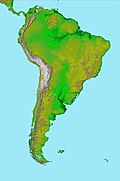Sunsás orogeny
Appearance
The Sunsás orogeny was an ancient orogeny active during the Late Paleoproterozoic and Mesoproterozoic and currently preserved as the Sunsás orogen in the Amazonian Craton in South America. About 85% of the belt is covered by Phanerozoic sediments. Among the remaining 15% of the orogen exposed at surface the best outcrops lies around the Bolivia-Brazil border. It is thought that the original orogen once spanned an area from Venezuela to Argentina and Paraguay. The western and southeastern fringes of the Sunsás orogen have been incorporated into the Andean orogeny and the Brasiliano orogeny respectively. The Sunsás orogeny was active during four separate phases:[1]
- Santa Helena orogeny 1465–1427 Ma
- Candeias orogeny 1371–1319 Ma
- San Andrés orogeny ca. 1275 Ma
- Nova Brasilândia orogeny 1180–1110 Ma
References
- ^ Santos, J.O.S.; Rizzotto, G.J.; Potter, P.E.; McNaughton, N.J.; Matos, R.S.; Hartmann, L.A.; Chemale Jr., F.; Quadros, M.E.S. (2008). "Age and autochthonous evolution of the Sunsás Orogen in West Amazon Craton based on mapping and U–Pb geochronology". Precambrian Research. 165 (3–4): 120–152. doi:10.1016/j.precamres.2008.06.009.

